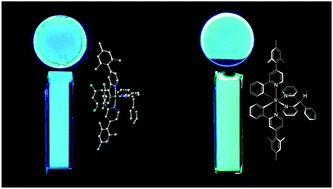当前位置:
X-MOL 学术
›
Dalton Trans.
›
论文详情
Our official English website, www.x-mol.net, welcomes your
feedback! (Note: you will need to create a separate account there.)
Phosphorescent cationic iridium(iii) complexes bearing a nonconjugated six-membered chelating ancillary ligand: a strategy for tuning the emission towards the blue†
Dalton Transactions ( IF 3.5 ) Pub Date : 2018-03-06 00:00:00 , DOI: 10.1039/c8dt00467f Claus Hierlinger 1, 2, 3, 4, 5 , David B. Cordes 6, 7, 8, 9, 10 , Alexandra M. Z. Slawin 6, 7, 8, 9, 10 , Denis Jacquemin 5, 11, 12, 13, 14 , Véronique Guerchais 1, 2, 3, 4, 5 , Eli Zysman-Colman 6, 7, 8, 9, 10
Dalton Transactions ( IF 3.5 ) Pub Date : 2018-03-06 00:00:00 , DOI: 10.1039/c8dt00467f Claus Hierlinger 1, 2, 3, 4, 5 , David B. Cordes 6, 7, 8, 9, 10 , Alexandra M. Z. Slawin 6, 7, 8, 9, 10 , Denis Jacquemin 5, 11, 12, 13, 14 , Véronique Guerchais 1, 2, 3, 4, 5 , Eli Zysman-Colman 6, 7, 8, 9, 10
Affiliation

|
This study concerns an assessment of the impact of the interruption of the electronic crosstalk between the pyridine rings in the ancillary ligand on the photoluminescence properties of the corresponding iridium(III) complexes. Two new cationic Ir(III) complexes, [Ir(dFmesppy)2(pmdp)]PF6, 1, and [Ir(mesppy)2(pmdp)]PF6, 2, [where dFmesppy is 2-(2,4-difluorophenyl)-4-mesitylpyridinato, mesppy is 4-mesityl-2-phenylpyridinato and pmdp is 2,2′-(phenylmethine)dipyridine, L1] possessing sterically congested cyclometalating ligands combined with the nonconjugated diimine ancillary N^N ligand are reported and their solution-state and thin film photophysical properties analyzed by both experimental and theoretical methods. The crystal structure of 1 confirms the formation of a six-membered chelate ring by the N^N ligand and illustrates the pseudo-axial configuration of the phenyl substituents. Upon photoexcitation in acetonitrile, both complexes exhibit a ligand-centered emission profile in the blue-green region of the visible spectrum. A significant blue-shift is observed in solution at room temperature compared to the analogous reference Ir(III) complexes (R1 and R2) bearing 4,4′-di-tert-butyl-2,2′-bipyridine (dtBubpy) as the N^N ligand. The computational investigation demonstrates that the HOMO is mainly centered on the metal and on both cyclometalating aryl rings of the C^N ligands, whereas the LUMO is principally localized on the pyridyl rings of the C^N ligands. The photoluminescence quantum yield is reduced compared to the reference complexes, a probable consequence of the greater flexibility of the ancillary ligand.
中文翻译:

带有非共轭六元螯合辅助配体的 磷光阳离子铱(iii)配合物:调整发射向蓝色的策略†
这项研究涉及评估辅助配体中吡啶环之间的电子串扰的中断对相应铱(III)配合物的光致发光性质的影响。两个新的阳离子的Ir(III)络合物,物[Ir(dFmesppy)2(PMDP)] PF 6,1和[Ir(mesppy)2(PMDP)] PF 6,2,[其中dFmesppy是2-(2,4- -二氟苯基)-4-mesitylpyridinato,mesppy是4-mesityl-2-phenylpyridinato,pmdp是2,2'-(phenylmethine)dipyridine,L1报道了具有与非共轭二亚胺辅助N ^ N配体组合的空间拥挤的环金属化配体,并通过实验和理论方法分析了它们的溶液态和薄膜光物理性质。的晶体结构1由N 1,N配体证实了六元螯合环的形成,并示出所述苯基取代基的伪轴向配置。在乙腈中进行光激发后,两种络合物在可见光谱的蓝绿色区域均显示出以配体为中心的发射曲线。与带有4,4'-二价的类似参比Ir(III)配合物(R1和R2)相比,室温下溶液中观察到了显着的蓝移。-N,N-配体的2,2′-丁基-联吡啶(d t Bubpy)。计算研究表明,HOMO主要集中在金属和C ^ N配体的两个环金属化芳基环上,而LUMO主要位于C ^ N配体的吡啶基环上。与参考配合物相比,光致发光量子产率降低,这可能是辅助配体具有更大柔韧性的结果。
更新日期:2018-03-06
中文翻译:

带有非共轭六元螯合辅助配体的 磷光阳离子铱(iii)配合物:调整发射向蓝色的策略†
这项研究涉及评估辅助配体中吡啶环之间的电子串扰的中断对相应铱(III)配合物的光致发光性质的影响。两个新的阳离子的Ir(III)络合物,物[Ir(dFmesppy)2(PMDP)] PF 6,1和[Ir(mesppy)2(PMDP)] PF 6,2,[其中dFmesppy是2-(2,4- -二氟苯基)-4-mesitylpyridinato,mesppy是4-mesityl-2-phenylpyridinato,pmdp是2,2'-(phenylmethine)dipyridine,L1报道了具有与非共轭二亚胺辅助N ^ N配体组合的空间拥挤的环金属化配体,并通过实验和理论方法分析了它们的溶液态和薄膜光物理性质。的晶体结构1由N 1,N配体证实了六元螯合环的形成,并示出所述苯基取代基的伪轴向配置。在乙腈中进行光激发后,两种络合物在可见光谱的蓝绿色区域均显示出以配体为中心的发射曲线。与带有4,4'-二价的类似参比Ir(III)配合物(R1和R2)相比,室温下溶液中观察到了显着的蓝移。-N,N-配体的2,2′-丁基-联吡啶(d t Bubpy)。计算研究表明,HOMO主要集中在金属和C ^ N配体的两个环金属化芳基环上,而LUMO主要位于C ^ N配体的吡啶基环上。与参考配合物相比,光致发光量子产率降低,这可能是辅助配体具有更大柔韧性的结果。











































 京公网安备 11010802027423号
京公网安备 11010802027423号